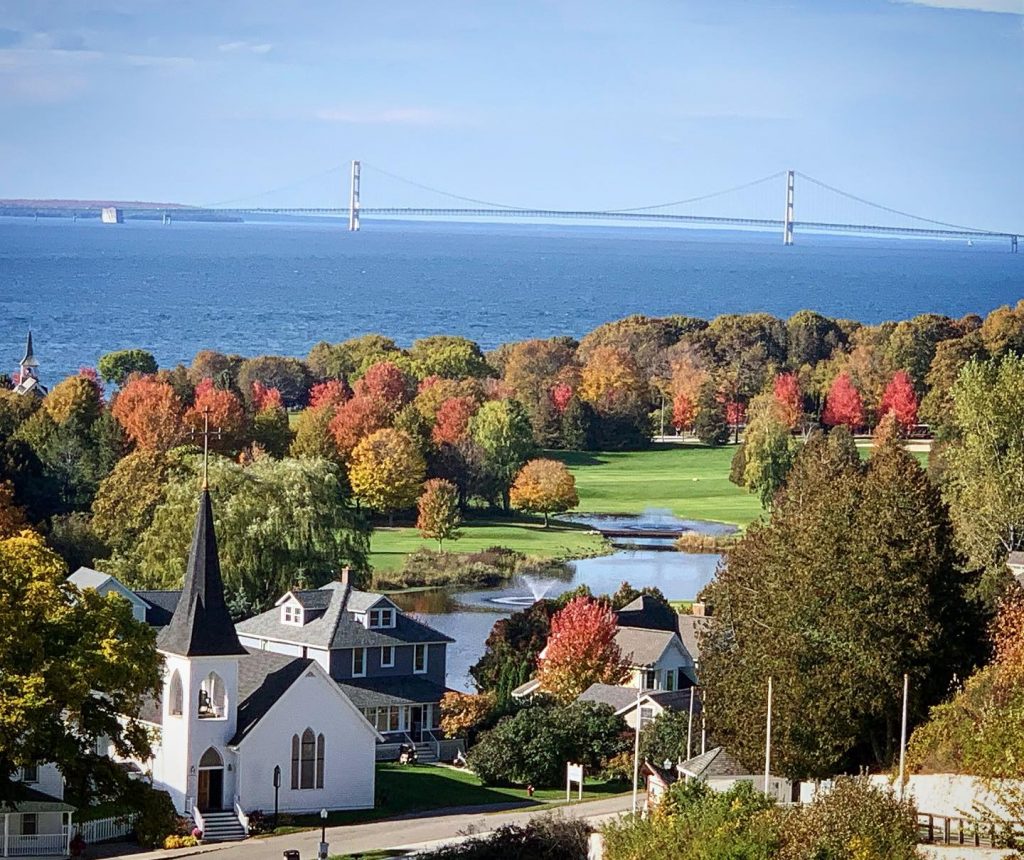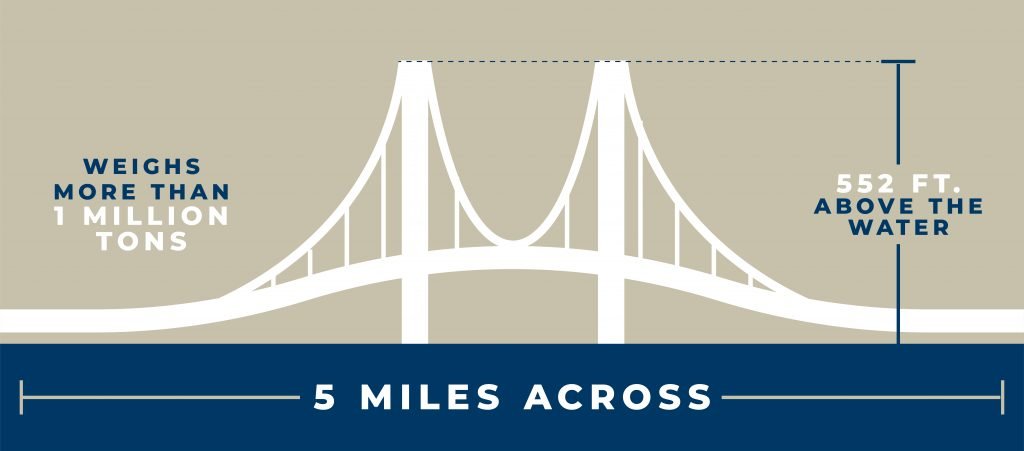With a total length of five miles, the Mackinac Bridge remains one of the longest bridges in the world even more than 60 years after it opened. The “Mighty Mac” is an impressive structure that weighs more than 1 million tons and reaches a height of 552 feet above the water as it stretches between Michigan’s Upper and Lower peninsulas.
Yet, the Mackinac Bridge as we know it today is only one-fifth the length of an alternative bridge that was suggested 100 years ago.
Did you know that a 1920s proposal would have routed vehicles along a 25-mile path of bridges and causeways between the two peninsulas. And that it would have passed right through Mackinac Island?!?
The plan to build the Mackinac Bridge to Mackinac Island
As interest grew in a motorized link over the Straits of Mackinac between Michigan’s two peninsulas, the state Legislature solicited ideas, according to the Mackinac Bridge Authority. A New York City engineer, C. E. Fowler, proposed a series of bridges and causeways that would take traffic on an island-hopping route from Cheboygan in the Lower Peninsula through Bois Blanc, Round and Mackinac Islands and then on to St. Ignace in the Upper Peninsula.
In fact, survey markers for the planned road alignment still exist on Bois Blanc Island. This news report shows a map of the proposed route and talks about how the Cheboygan-to-St. Ignace connector would have changed the nature of the islands and the entire Straits of Mackinac.
Beloved features of car-free Mackinac Island
More than 4 million vehicles cross the Mackinac Bridge each year. In July and August, the busiest months of the year for the “Mighty Mac,” bridge traffic averages 20,000 vehicles per day. That kind of traffic would completely change the character of car-free Mackinac Island, where motor vehicles have been banned since 1898!
Could you imagine the freeway running through Mackinac Island? It’s hard to envision exactly what Mackinac Island might look like today had Michigan acted on Fowler’s plan a century ago. But it’s a good bet that many of these distinctive features would have been lost to history:
-
Mackinac Island ferry boats
Would there be a need to shuttle passengers back and forth from the mainland if people could just drive straight to Mackinac Island? The Mackinac Island ferry ride from either St. Ignace or Mackinaw City is one of many things that makes visiting Mackinac Island a truly unique experience.
What to do with your car when you go to Mackinac Island
-
Horse-drawn carriage tours of Mackinac Island
Mackinac Island leaders voted to ban cars (a.k.a. “horseless carriages”) in 1898 because the newfangled vehicles scared the horses! Undoubtedly, the clip-clop pace of Mackinac Island would have been forever changed had thousands of motor vehicles started arriving daily on a bridge from the mainland.
7 sights to see on a horse-drawn carriage tour of Mackinac Island
-
Bicycles on Mackinac Island
One of the more popular things to do on Mackinac Island is riding a bike, and many visitors like to pedal all the way around the outer rim of the island on M-185. The 8.2-mile route makes for an enjoyable, leisurely ride precisely because there are no motor vehicles. In fact, M-185 is the only state highway in the country that prohibits automobiles!
What to expect on the 8.2-mile bike ride around Mackinac Island
-
Historic character of Mackinac Island
Who knows how a bridge might have affected Mackinac Island’s historic attractions and the natural wonders of Mackinac Island State Park? Would Fort Mackinac ever have been restored into the living history museum that it is today? Could Mackinac Island’s stunning geological features such as Sugar Loaf have been preserved? Would Mackinac Island still be an outdoor recreation paradise?
Things to do on Mackinac Island for history buffs
As it turned out, the state decided against Fowler’s plan and three decades later forged ahead with construction of the current Mackinac Bridge, which links Michigan’s Upper and Lower peninsulas without connecting to Mackinac Island. As a result, there’s no road to Mackinac Island and to this day it remains car free.
Fortunately, Mackinac Island still feels a lot like it did back in 1920!
RELATED MACKINAC ISLAND BLOGS:







